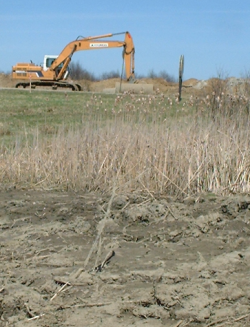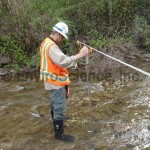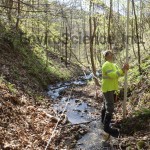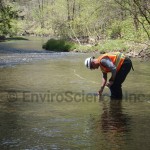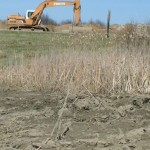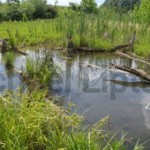401 & 404 Permits
Wetlands, streams, lakes, ponds and other waters are regulated by state and federal law, and permits are required to impact these water bodies. Obtaining state and federal wetland permits can be a time-consuming process that can take up to a year. Therefore, a preliminary site assessment should be conducted early in the project to prevent delays.
EnviroScience supports clients through the entire permitting process, making sure clients complete projects on schedule. Our state-of-the-art delineation service identifies, delineates, and surveys all jurisdictional waters on the site. We provide a detailed report of findings designed to satisfy all regulatory requirements and a digital map plan to supplement your engineering and planning objectives.
Our experts can guide you through the regulatory decision-making process and work with you to minimize impacts, creating a cost effective design that meets your development goals. If impacts are unavoidable, our team of biologists experienced in preparing fill permits and compensatory mitigation projects that satisfy requirements of the Environmental Protection Agency (EPA) and the U.S. Army Corps of Engineers (USACE).
EnviroScience’s full-time professionals are trained and experienced in 401 & 404 permitting, keep up-to-date on all regulatory changes, and are skilled at communicating with agency reviewers. Our personnel are known and respected in the Buffalo and Huntington District Offices of the USACE, the Ohio Environmental Protection Agency, as well as out-of-state regulators throughout the eastern U.S. This allows our biologists to obtain rapid regulatory approval for projects.
ES personnel have significant experience with the following permits:
- Section 404 Permitting
- Section 401 Water Quality Certifications
- Isolated Wetland Permitting
- Wetland Fills
Total Maximum Daily Load Assessements
A TMDL, or Total Maximum Daily Load, can refer to both a numeric water quality criteria, as well as a process by which such criteria are calculated. Considerable regulatory attention is currently being directed toward TMDL development at both the state and federal level. Despite the tremendous progress in cleaning up the nation’s waterways since the Clean Water Act was enacted, a significant number of the nations waterways are not in compliance with applicable water use designations. The TMDL process is seen by USEPA and the states as a mechanism for bringing these waterways into compliance. In general, a TMDL establishes the maximum amount of a pollutant a water body can assimilate without exceeding the applicable water quality standard.
The TMDL process uses many diagnostic and regulatory tools that have been in use for many years such as chemistry and biota monitoring, modeling, and wasteload allocation. These tools are used and TMDLs are developed for specific stream segments that are in non-attainment of one or more criteria (i.e., chemical, biological).
Where the TMDL process differs from past approaches is that it goes well beyond municipal and industrial point source discharges when evaluating causes of impairment and possible solutions. By design, the TMDL process looks at the full range of contributing factors including non-point source pollution, storm water runoff, sediment contamination, agricultural inputs and land use patterns. Public participation is an important component in the development of most TMDLs because many of the most important causative factors for non-attainment are often outside of the direct control of the environmental agencies charged with water quality management.
NEPA Compliance
EnviroScience has extensive experience in assisting clients in complying with the National Environmental Policy Act (NEPA) requirements in a time-effective manner.
WHAT IS NEPA?
NEPA is a federal policy that considers environmental impacts during federal planning and decision-making. This law seeks to create a balance between humans and the environment by evaluating potential impacts upon the environment while fulfilling the social, economic, and technical agenda of government actions and the reasonable alternatives to those actions. In addition, this policy requires that potential major federal action be disclosed to potentially affected parties and any comments or concerns from these parties be evaluated in the decision making process. The final result is improved federal decision making.
After the federal agency’s proposed action and the alternatives are established, they are evaluated one of three ways; Categorical Exclusion, Environmental Assessment (EA), or Environmental Impact Statement (EIS). Categorical Exclusion indicate no significant individual or cumulative effect on the quality of the environment or humans. If however the proposed action does not meet the Categorical Exclusion criteria or if the agency is unsure if the proposed action will have impacts, an EA or EIS is indicated.
THE NEPA PROCESS
An EA is prepared if the proposed action and the alternatives are determined to have potentially significant environmental effects. This process involves affected or concerned party participation including federal, state, and local agencies, the applicant, and to the extent practicable, the public. The EA process results in either a Finding of No Significant Impact (FONSI) or an EIS must be prepared.
An EIS is more extensive than a Categorical Exclusion or EA. In an EIS, a full range of alternatives must be evaluated along with the preferred alternative and the no action alternative. For example, under Section 309 of the Clean Air Act, the EPA is required to review the EISs of federal agencies and comment on any issues. The EIS process culminates with a Record of Decision (ROD) that describes the alternatives, the preferred alternative, and the mitigating measures to reduce environmental impacts.
In Action
#gallery-2 { margin: auto; } #gallery-2 .gallery-item { float: left; margin-top: 10px; text-align: center; width: 25%; } #gallery-2 img { border: 2px solid #cfcfcf; } #gallery-2 .gallery-caption { margin-left: 0; } /* see gallery_shortcode() in wp-includes/media.php */
Need help with your project?
Our experts are here to discuss your needs and how we can help you move your project forward. Fill out the form below for more information on our services or to request a quote and we’ll get back to you within 24 hours. If you need a response within an hour or less, please call us at 800-940-4025.
Your Name (required)
Your Email (required)
Your Phone Number
Subject
Which services are you interested in?
Wetland Delineation & Permitting
Environmental Sampling
Aquatic Threatened/Endangered Species Surveys
Terrestrial Threatened/Endangered Species Surveys
Stream/Wetland Restoration
Bioassay & Sediment Toxicity
Environmental Inspection (Erosion & Sediment)
Environmental Permit Compliance
Commercial Diving
Property Due Diligence
Stormwater Design
Other (Please Specify)
Your Message
Few environmental firms in the country retain EnviroScience’s degree of scientific know-how, talent, and capability under one roof. The diverse backgrounds of our biologists, environmental engineers, scientists, and divers enable us to provide comprehensive in-house services and an integrated approach to solving environmental challenges—saving clients time, reducing costs, and ensuring high-quality results.
Our client guarantee is to provide “Excellence in Any Environment,” meaning no matter what we do, we will deliver on our Core Values of respect, client advocacy, quality work, accountability, teamwork, and safety. EnviroScience was created with the concept that we could solve complex problems by empowering great people. This concept still holds true today as our scientists explore the latest environmental legislation and regulations and incorporate the most up-to-date technology to gather and report data.
EnviroScience expertise includes but is not limited to: aquatic survey (including macroinvertebrate surveys and biological assessments); ecological restoration; ecological services (including impact assessments, invasive species control, and water quality monitoring); emergency response; engineering and compliance services; endangered mussel surveys; laboratory and analysis; stormwater management; threatened and endangered species; and wetlands and streams (including delineation and mitigation). Further, EnviroScience is one of the few biological firms in the country that is a general member of the Association of Diving Contractors International (ADCI) and offers full-service commercial diving services.
